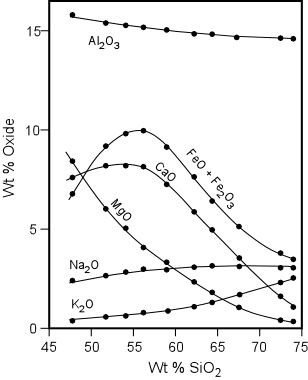
| EENS 2120 |
Petrology |
| Prof. Stephen A. Nelson |
Tulane University |
|
Magmatic Differentiation |
|
Chemical Variation in Rock Suites Soon after geologists began doing chemical analyses of igneous rocks they realized that rocks emplaced in any given restricted area during a short amount of geologic time were likely related to the same magmatic event. Evidence for some kind of relationship between the rocks, and therefore between the magmas that cooled to form the rocks came from plotting variation diagrams. |
| A variation diagram is a plot showing how each oxide component in a rock varies with some other oxide component. Because SiO2 usually shows the most variation in any given suite of rocks, most variation diagrams plot the other oxides against SiO2 as shown in the diagram here, although any other oxide could be chosen for plotting on the x-axis. Plots that show relatively smooth trends of variation of the components suggested that the rocks might be related to one another through some process. Of course, in order for the magmas to be related to one another, they must also have been intruded or erupted within a reasonable range of time. Plotting rocks of Precambrian age along with those of Tertiary age may show smooth variation, but it is unlikely that the magmas were related to one another. |
 |
If
magmas are related to each other by some processes, that process would have to be one that
causes magma composition to change. Any process that causes magma composition to change is called magmatic
differentiation. Over the years, various process have been suggested to
explain the variation of magma compositions observed within small regions. Among the
processes are:
|
| Initially, researchers attempted to show that one or the other of these process acted
exclusively to cause magmatic differentiation. With historical perspective, we now
realize that if any of them are possible, then any or all of these processes could act at
the same time to produce chemical change, and thus combinations of these processes are
possible. Still, we will look at each one in turn in the following discussion. |
Distinct Melting Events One possibility that always exists is that the magmas are not related except by some
heating event that caused melting. In such a case each magma might represent melting
of a different source rock at different times during the heating event. If this were
the case, we might not expect the chemical analyses of the rocks produced to show smooth
trends on variation diagrams. But, because variation diagrams are based on a closed set
of numbers (chemical analyses add up to 100%), if the weight% of one component increases,
then the weight percent of some other component must decrease. Thus, even in the
event that the magmas are not related, SiO2 could increase and MgO could
decrease to produce a trend. The possibility of distinct melting events is not easy
to prove or disprove. |
Various Degrees of Partial Melting We have seen in our study of simple phase diagrams that when a multicomponent rock system melts, unless it has the composition of the eutectic, it melts over a range of temperatures at any given pressure, and during this melting, the liquid composition changes. Thus, a wide variety of liquid compositions could be made by various degrees of partial melting of the same source rock. |
| To see this, lets look at a simple example of a three component system containing natural minerals, the system Fo - Di - SiO2, shown in simplified form here. A proxy for mantle peridotite, being a mixture of Ol, Cpx, and Opx would plot as shown in the diagram. This rock would begin to melt at the peritectic point, where Di, En, Ol, and Liquid are in equilibrium. The composition of the liquid would remain at the peritectic point (labeled 0% melting) until all of the diopside melted. This would occur after about 23% melting. The liquid would then take a path shown by the dark curve, first moving along the En - Ol boundary curve, until the enstatite was completely absorbed, then moving in a direct path toward the peridotite composition. | 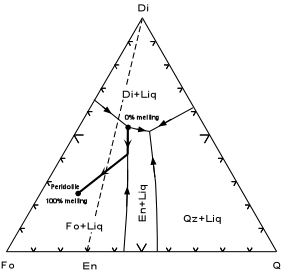 |
| At 100% melting the liquid would have the composition of the initial peridotite.
So long as some of the liquid is left behind, liquids can be extracted at any time
during the melting event and have compositions anywhere along the dark like between 0%
melting and 100% melting. (Note that the compositions between 0% melting and where
the dark line intersects the En-Di join are SiO2 oversaturated liquids, and
those from this point up to 100% melting are SiO2 undersaturated liquids).
Fractional
Melting |
| In fractional melting all of the liquid is removed at each stage of the process. Let's imagine that we melt the same peridotite again, removing liquids as they form. The first melt to form again will have a composition of the peritectic, labeled "Melt 1" in the diagram. Liquids of composition - Melt 1 can be produced and extracted until all of the Diopside is used up. At this point, there is no liquid, since it has been removed or fractionated, so the remaining solid consists only of Enstatite and Forsterite with composition "Solid 2". This is a two component system. Thus further melting cannot take place until the temperature is raised to the peritectic temperature in the two component system Fo- SiO2. | 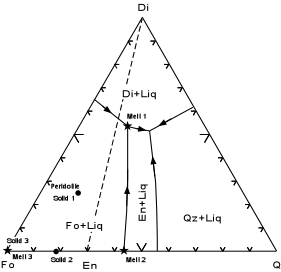 |
| Melting at this temperature produces a liquid of composition "Melt 2".
Further melting and removal of this liquid, eventually results in all of the
Enstatite being used up. At this point, all that is left in the rock is Forsterite.
Forsterite melts at a much higher temperature, so further melting cannot take place until
the temperature reaches the melting temperature of pure Forsterite. This liquid will
have the same composition as pure Forsterite ("Melt 3").
We saw in our discussion of how magmas are generated that it is difficult enough to get the temperature in the Earth above the peridotite solidus, let alone to much higher temperatures. Thus, fractional melting is not very likely to occur in the Earth. Trace Elements as Clues to Suites Produced by Various Degrees of Melting
|
|
When a mantle rock begins to melt, the incompatible elements will be ejected
preferentially from the solid and enter the liquid. This is because if these elements
are present in minerals in the rock, they will not be in energetically favorable sites in
the crystals. Thus, a low degree melt of a mantle rock will have high concentrations of
incompatible elements. As melting proceeds the concentration of these incompatible
elements will decrease because (1) there will be less of them to enter the melt, and (2)
their concentrations will become more and more diluted as other elements enter the
melt. Thus, incompatible element concentrations will decrease with
increasing % melting. |
| Using equations that describe how trace elements are partitioned by solids and liquids, concentrations of REEs in melts from garnet peridotite can be calculated. These are shown in the diagram, where REE concentrations have been normalized by dividing the concentration of each element by the concentration found in chondritic meteorites. | 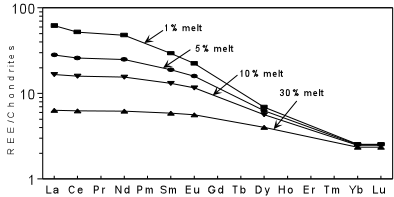 |
| This produces a REE pattern. Note that the low % melts have Light REE enriched patterns, because the low atomic weight REEs (La - Eu) are enriched over the heavier REEs. |
| Next, we plot the ratio of a highly incompatible element, like La, to a less incompatible element, like Sm, versus the concentration of the highly incompatible element. In the case shown, La/Sm ratio versus La concentration for each % melting. Note the steep slope of the curves connecting the points. | 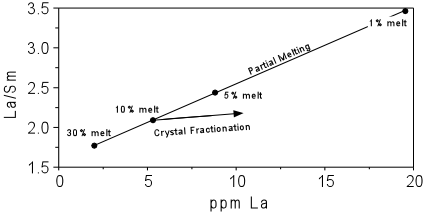 |
| As we'll see in our discussion of crystal fractionation, the ratios of incompatible
elements do not change much with crystal fractionation, and therefore produce a trend with
a less steep slope. This gives us a method for distinguishing between partial
melting and crystal fractionation as the process responsible for magmatic differentiation. |
Crystal Fractionation In our discussion of phase diagrams we saw how liquid compositions can change as a result of removing crystals from the liquid as they form. In all cases except a eutectic composition, crystallization results in a change in the composition of the liquid, and if the crystals are removed by some process, then different magma compositions can be generated from the initial parent liquid. If minerals that later react to form a new mineral or solid solution minerals are removed, then crystal fractionation can produce liquid compositions that would not otherwise have been attained by normal crystallization of the parent liquid.
|
|
Bowen suggested that the common minerals that crystallize from magmas could be divided
into a continuous reaction series and a discontinuous reaction series.
|
This generalized idea is consistent with the temperatures observed in magmas and with the mineral assemblages we find in the various rocks. We would expect that with increasing SiO2 oxides like MgO, and CaO should decrease with higher degrees of crystal fractionation because they enter early crystallizing phases, like olivines and pyroxenes. Oxides like H2O, K2O and Na2O should increase with increasing crystal fractionation because they do not enter early crystallizing phases. Furthermore, we would expect incompatible trace element concentrations to increase with fractionation, and compatible trace element concentrations to decrease. This is generally what is observed in igneous rock suites. Because of this, and the fact that crystal fractionation is easy to envision and somewhat easy to test, crystal fraction is often implicitly assumed to be the dominant process of magmatic differentiation. |
Graphical Representation of Crystal Fractionation |
In a simple case imagine that we have two rocks, A and B, with their SiO2 and MgO concentrations as shown in the diagram. Also plotted is the analysis of olivine contained in rock A. Removal of olivine from Rock A would drive the liquid composition in a straight line away from A. (This is the same idea we used in phase diagrams). If rock B were produced from rock A by fractionation of olivine, then the composition of rock B should lie on the same line.
|
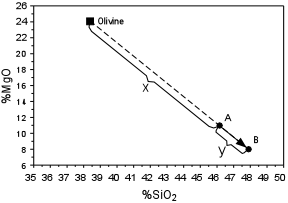 |
| This should also be true
of all other variation diagrams plotting other oxides against SiO2.Just like in phase diagrams we can apply the lever rule to determine how much of the
olivine had to fractionate from a magma with composition A to produce rock B:
%Olivine Fractionated = [y/(x + y)]*100 If olivine fractionation were the process responsible for the change from magma A to magma B, then these proportions would have to be the same on all other variation diagrams as well.
|
In a more complicated case, we next look at what happens if two phases of different composition were involved in the fractionation. Again the rules we apply are the same rules we used in phase diagrams. |
| In this case, a mixture of 50% olivine and 50% pyroxene has been removed
from magma C to produce magma D. Note that the liquid composition has to change
along a line away from the composition of the mixture of solid phases, through the
composition of the original liquid (magma C). Again the lever rule would tell us
that the percentage of solids fractionated would be:
%solids fractionated = [z/(w + z)]*100 |
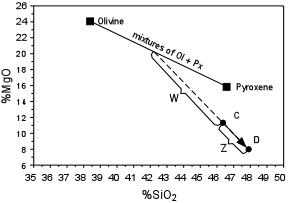 |
This works well for small steps in the fractionation sequence. In the real world we find that many minerals expected to crystallize from a magma are solid solutions whose compositions will change as the liquid evolves and temperature drops. We can see how this would affect things with the following example. In this case we look at what happens if an Mg-Fe solid solution mineral is removed as temperature falls.
|
| The initial magma has high MgO and low SiO2. The solid crystallizing from this magma also has high MgO and low SiO2. Taking the fractionation in small increments, the second magma produced by removing the solids from the original magma will have higher SiO2 and lower MgO.
|
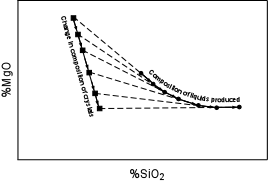 |
But, the second liquid will be crystallizing a solid with lower MgO and higher, SiO2, so it will evolve along a different path. The net result will be that the variation will show a curved trend on a variation diagram. Thus, a generalization we can make is that in natural magmas we expect the variation to be along smooth curved trends since most of the minerals that crystallize from magmas are solid solutions. Note that different minerals fractionated will produce different trends, but they will still be smooth and curved.
|
| In the example shown a series of magmas are produced along segment 1 by fractionating a combination of solids with low FeO and low SiO2. The last magma produced along segment 1 of the variation diagram has different mineral phases in equilibrium. These phases (probably including a mineral with high FeO, like magnetite) have a much higher FeO concentration. Removal of these phases from this magma causes the trend of variation to make a sharp bend, and further fractionation causes liquids to evolve along segment 2. |
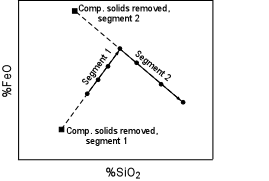 |
Thus, sudden changes in the trends on variation diagrams could mean that there has
been a change in the mineral assemblage being fractionated. |
Trace Elements and Crystal Fractionation
|
Note that the REE patterns produced by higher percentages of crystal fractionation show higher concentrations, yet the patterns remain nearly parallel to one another. Thus, a suite of rocks formed as a result of crystal fractionation should show nearly parallel trends of REE patterns. |
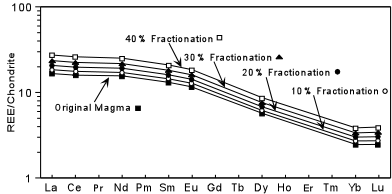 |
| Referring back to our discussion of REEs during partial melting, recall that we said
that during crystal fractionation the ratios of incompatible elements show little change,
and that we can use this factor to distinguish between crystal fractionation and partial
melting. |
| Mechanisms of Crystal Fractionation In order for crystal fractionation to operate their must be a natural mechanism that can remove crystals from the magma or at least separate the crystals so that they can no longer react with the liquid. Several mechanisms could operate in nature. |
|
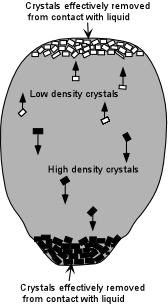 |
|
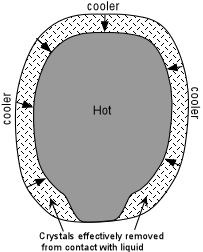 |
|
Magma Mixing If two or more magmas with different chemical compositions come in contact with one another beneath the surface of the Earth, then it is possible that they could mix with each other to produce compositions intermediate between the end members. If the compositions of the magmas are greatly different (i.e. basalt and rhyolite), there are several factors that would tend to inhibit mixing.
|
Despite these inhibiting factors, there is evidence in rocks that magmas do sometimes mix. The smaller the difference in chemical composition between two magmas, the smaller will be the contrasts in temperature, density, and viscosity. If magmas of contrasting composition come in contact and begin to mix some kind of stirring mechanism would first be necessary. Such stirring could be provided by convection, with the hotter magma rising through the cooler magma. Evidence for Mixing |
|
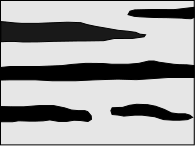 |
|
|
Mg-Fe solid solution minerals normally zone from Mg-rich cores to Fe-rich rims. If a Fe-rich olivine or pyroxene is mixed into a Mg-rich magma that is precipitating Mg-rich olivine or pyroxene, it may precipitate the more Mg-rich composition on the rims of the added crystals. Analyses of such crystals would reveal a reversal in zoning. Similarly, if a Na-rich plagioclase originally crystallizing from a rhyolitic magma were mixed into a basaltic magma precipitating a Ca-rich plagioclase, a Ca-rich rim may be added to the Na-rich plagioclase. |
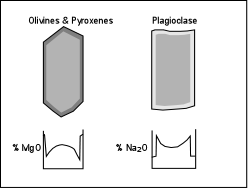 |
|
Since the glass inclusions should represent the composition of the magma that precipitated the crystal, chemical analysis of glass inclusions give us the composition of the liquid in which the crystal formed. The groundmass may also contain glass representing the composition of the liquid in which the crystal resided at eruption. If the composition of glass inclusions is different from glass in the groundmass, and if the groundmass composition is not what is expected from normal crystallization of the minerals present, this provides evidence of magma mixing. |
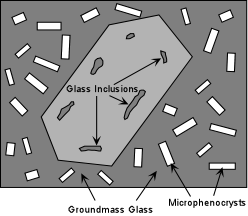 |
|
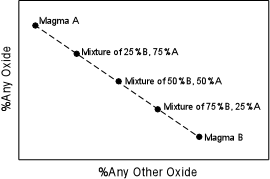 |
|
Crustal Assimilation/Contamination Because the composition of the crust is generally different from the composition of magmas which must pass through the crust to reach the surface, their is always the possibility that reactions between the crust and the magma could take place. If crustal rocks are picked up, incorporated into the magma, and dissolved to become part of the magma, we say that the crustal rocks have been assimilated by the magma. If the magma absorbs part of the rock through which it passes we say that the magma has become contaminated by the crust. Either of these process would produce a change in the chemical composition of the magma unless the material being added has the same chemical composition as the magma. In a sense, bulk assimilation would produce some of the same effects as mixing, but it is more complicated than mixing because of the heat balance involved. In order to assimilate the country rock enough heat must be provided to first raise the country rock to its solidus temperature where it will begin to melt and then further heat must be added to change from the solid state to the liquid state. The only source of this heat, of course, is the magma itself.
|
| Let's imagine a simple case of a pure mineral making up the country rock
that is to be assimilated. In order to raise the temperature of the country rock
from its initial temperature, Ti, to its melting temperature, Tm,
heat must be provided. The amount of heat required is determined by the heat
capacity of the rock, Cp (the p subscript stands for constant pressure).
|
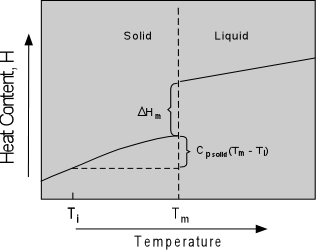 |
| Once the temperature has risen to Tm, further heat must be added to melt
the rock. This heat is known as the heat of melting, ΔHm
, also sometimes called the latent heat of fusion.
As stated above the heat required for
this process must be supplied by the magma. In our example we'll take a simple case
where the magma has a eutectic composition and therefore melts at a single temperature.
This time we'll assume that the magma is at a temperature, TL, somewhat
above its melting Temperature, Tm. |
In order to provide the heat for assimilation it would first have to cool. The amount of heat it would give up would then be:
Once it reached Tm the only other source of heat must be provided by crystallization to release the latent heat of crystallization, ΔHc. Note that in the case shown here, the total heat released by the magma in cooling to Tm and crystallizing is still not enough to melt the country rock. |
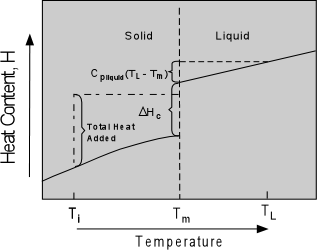 |
Furthermore, in this process the magma has completely crystallized, so assimilation cannot take place. There are two ways to overcome this problem: (1) If the initial temperature of the magma were much higher, then it could provide the heat by simply cooling to its melting temperature. This is unrealistic, however, because magmas are probably relatively close to or below their liquidus temperature after having passed through cooler country rocks. (2) If the country rock had an initial temperature closer to its melting temperature, less heat would have to be provided by the magma. This could happen if there were successive batches of magma passing through and releasing heat into the country rock. |
Nevertheless, this heat budget analysis illustrates the difficulty involved in bulk assimilation of country rock by magmas, and makes the process less attractive as a process to explain the chemical diversity of a suite of rocks. Note also that the heat budget will still likely involve crystallizing some of the magma, so if assimilation takes place it will likely involve a combined process of crystal fractionation and assimilation. |
| In a more realistic natural situation things will be slightly different because both the country rock and the magma will melt/crystallize over a range of temperatures, rather than at a single temperature. Even still, the amount of heat required to melt the rock must be provided over a relatively narrow range of temperature. But, partial assimilation of the country rock would be possible because the country rock would only have to be partially melted to produce a liquid that could mix with the magma. In this case we would say that the magma has been contaminated by the country rock. | 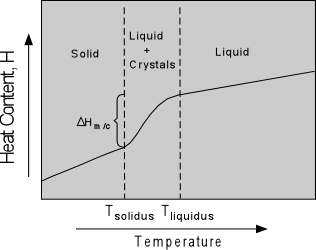 |
Evidence for Assimilation/Contamination
Perhaps the best evidence of assimilation/contamination comes from studies of radiogenic isotopes. Here we give an example using the systematics of the Rb - Sr system.
|
|
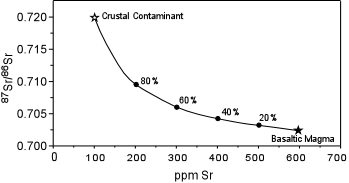 |
Liquid Immiscibility Liquid immiscibility is where liquids do not mix with each other. We are all familiar with this phenomenon in the case of oil and water/vinegar in salad dressing. We have also discussed immiscibility in solids, for example in the alkali feldspar system. Just like in the alkali feldspar system, immiscibility is temperature dependent. |
|
| For example, in a two component system if there is a field of immiscibility it would appear as in the diagram shown here. Cooling of a liquid with a composition of 25%B & 75%A would eventually result in the liquid separating into two different compositions. With further cooling one liquid would become more enriched in A and the other more enriched in B. Eventually both liquids would reach a temperature where crystals of A would start to form. Note that both liquids would be in equilibrium with crystals of A at the same temperature. Further cooling would result in the disappearance of the A-rich liquid. |
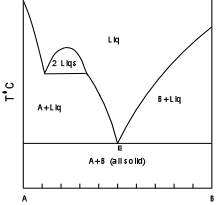 |
This points out two important properties of immiscible liquids.
Liquid immiscibility was once thought to be a mechanism to explain all magmatic differentiation. If so, requirement 2, above, would require that siliceous liquids and mafic liquids should form at the same temperature. Since basaltic magmas are generally much hotter than rhyolitic magmas, liquid immiscibility is not looked upon favorably as an explanation for wide diversity of magmatic compositions. Still, liquid immiscibility is observed in experiments conducted on simple rock systems.
|
For example, in the system Fo-An-Qz a field of immiscible
liquids is observed for compositions rich in SiO2. But
these compositions are outside of the range of compositions that occur in
nature. This is true of almost all simple systems wherein liquid
immiscibility has been observed. There are however, three exceptions
where liquid immiscibility may play a role.
|
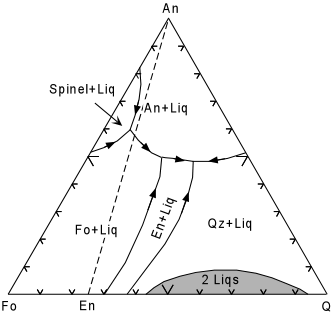 |
Combined Processes As pointed out previously, if any of these process are possible, then a combination of the process could act to produce chemical change in magmas. Thus, although crystal fractionation seems to be the dominant process affecting magmatic differentiation, it may not be the only processes. As we have seen, assimilation is likely to accompanied by crystallization of magmas in order to provide the heat necessary for assimilation. If this occurs then a combination of crystal fraction and assimilation could occur. Similarly, magmas could mix and crystallize at the same time resulting in a combination of magma mixing and crystal fractionation. In nature, things could be quite complicated.
|
Examples of questions on this material that could be asked on an exam
|